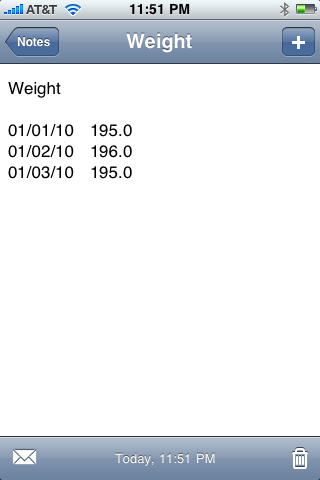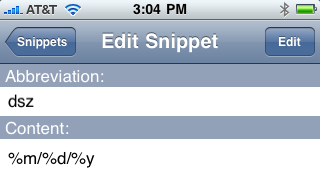Simplenote, TextExpander, and the scale
January 4, 2010 at 12:22 AM by Dr. Drang
Losing weight was not going to be one of my New Year’s resolutions. I just wanted to keep myself from gaining weight over the winter when I can’t ride my bike to and from work. But when I got on the scale a few weeks ago and found myself grazing the 200-pound mark, I knew that I’d already failed at keeping my weight steady and needed to start losing.
There are as many weight loss strategies as there are dieters. My plan is to simply think more carefully about what and how much I eat, and let the scale tell me how well I’m doing. I know that many people are dead set against weighing themselves every day; their theory being that your day-to-day weight fluctuation is too noisy to be a good measure of your progress. But for me, going a few days between weighings is just a license to lie to myself about my intake. I’m going to weigh myself every day and record it to keep myself honest.
I will not, as a general rule, be making the results public. I won’t be putting my weight up in the sidebar of the blog, nor will I set up a Twitter account for my weight as Leo Laporte has.1 This is not about shaming myself into losing; it’s about me keeping score for myself.
I’ll be using my iPhone to keep track of my weight. This is not just some nerdy love of technology, the phone is my most practical recording device. I keep my phone in the bathroom overnight to have it ready when I get dressed in the morning, so it’s already right where the scale is. And, like my car keys, my phone is something I have to pick up and pocket every morning. If I’m going to establish a habit of recording my weight, doing it on the iPhone seems like the easiest way to do it.
I’m sure there are dozens of iPhone apps that will help me track my weight. They’ll probably also graph it, calculate my BMI, and generate an autoregressive integrated moving average model. But I don’t want a new app, I just want to enter the date and weight as efficiently as I can. So I’ve decided to record my daily weight in Simplenote, an app that
- launches quickly,
- I’m familiar with, and
- can be streamlined with TextExpander.
Here’s what my note looks like so far.

I have to put three spaces between the date and the weight, otherwise the iPhone will interpret each line as a phone number and will turn it into a link—underlined and in blue.
I’m typing in the weight exactly as it’s displayed on my scale. It weighs to the nearest half pound, so eventually I’ll have some values that end with “.5” instead of “.0.”
I enter the date quickly via this TextExpander snippet:

The abbreviation is meant to indicate “date stamp”—I put a “z” at the end because “ds” is a combination that can appear in real words. I have TextExpander set to ignore the case of the abbreviation, so “Dsz” (which is what I’ll get at the beginning of the line because of the iPhone’s auto-capitalization) works the same as “dsz.”
The content uses the standard strftime format. Using two digits for the months, days, and years ensures vertical alignment.
There will, no doubt, come a time when I’ll want to graph my weight or do some sort of regression analysis. That’s when Simplenote’s automatic syncing will come in handy. I’ll copy the data from my Simplenote web page, paste it into a local text file or spreadsheet, and analyze to my heart’s content. For now I’m happy just to get into the daily routine of recording my weight.
-
I know he’s an internet celebrity and all, but doesn’t it strike you as odd that Leo’s scale has almost 1500 followers? ↩
